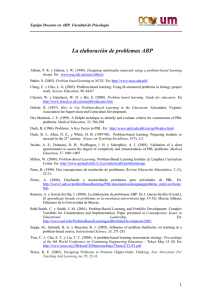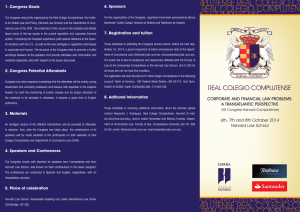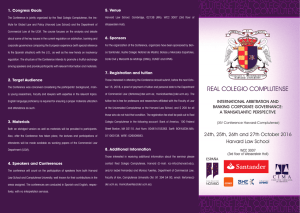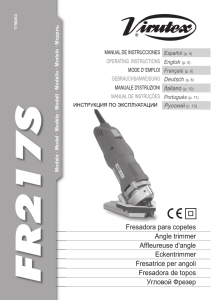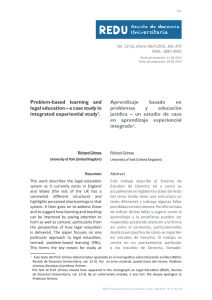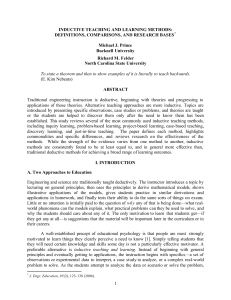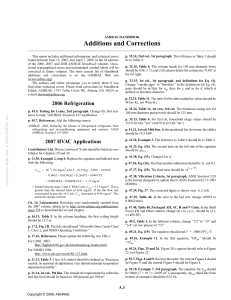problem-based learning and the use of new learning
Anuncio
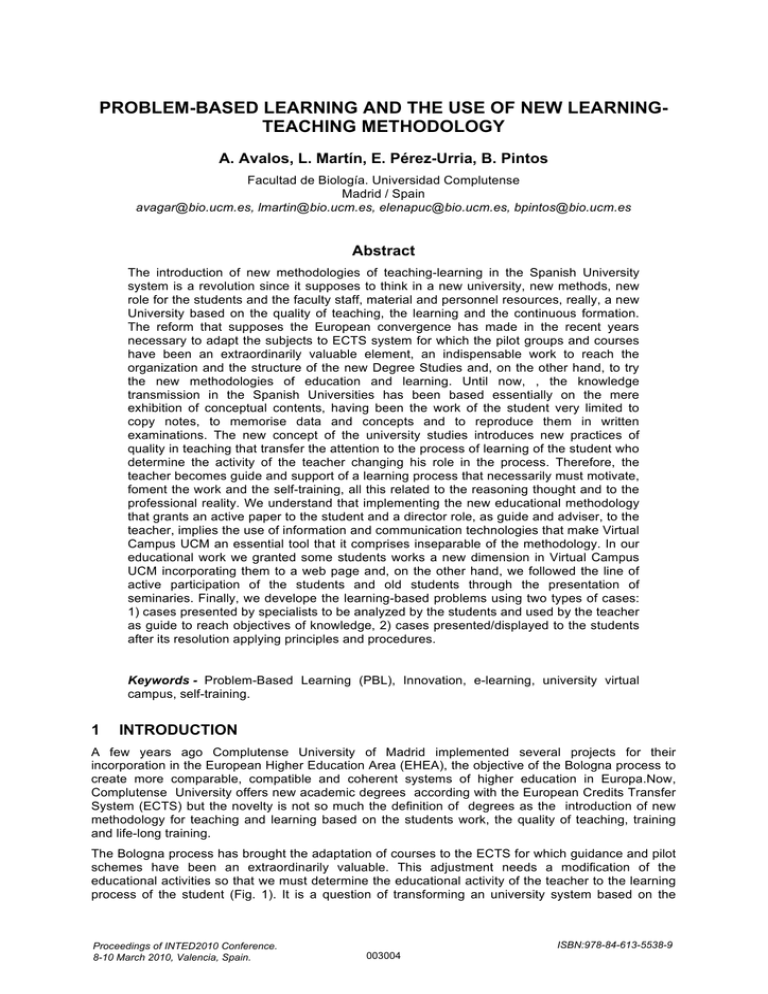
PROBLEM-BASED LEARNING AND THE USE OF NEW LEARNINGTEACHING METHODOLOGY A. Avalos, L. Martín, E. Pérez-Urria, B. Pintos Facultad de Biología. Universidad Complutense Madrid / Spain avagar@bio.ucm.es, lmartin@bio.ucm.es, elenapuc@bio.ucm.es, bpintos@bio.ucm.es Abstract The introduction of new methodologies of teaching-learning in the Spanish University system is a revolution since it supposes to think in a new university, new methods, new role for the students and the faculty staff, material and personnel resources, really, a new University based on the quality of teaching, the learning and the continuous formation. The reform that supposes the European convergence has made in the recent years necessary to adapt the subjects to ECTS system for which the pilot groups and courses have been an extraordinarily valuable element, an indispensable work to reach the organization and the structure of the new Degree Studies and, on the other hand, to try the new methodologies of education and learning. Until now, , the knowledge transmission in the Spanish Universities has been based essentially on the mere exhibition of conceptual contents, having been the work of the student very limited to copy notes, to memorise data and concepts and to reproduce them in written examinations. The new concept of the university studies introduces new practices of quality in teaching that transfer the attention to the process of learning of the student who determine the activity of the teacher changing his role in the process. Therefore, the teacher becomes guide and support of a learning process that necessarily must motivate, foment the work and the self-training, all this related to the reasoning thought and to the professional reality. We understand that implementing the new educational methodology that grants an active paper to the student and a director role, as guide and adviser, to the teacher, implies the use of information and communication technologies that make Virtual Campus UCM an essential tool that it comprises inseparable of the methodology. In our educational work we granted some students works a new dimension in Virtual Campus UCM incorporating them to a web page and, on the other hand, we followed the line of active participation of the students and old students through the presentation of seminaries. Finally, we develope the learning-based problems using two types of cases: 1) cases presented by specialists to be analyzed by the students and used by the teacher as guide to reach objectives of knowledge, 2) cases presented/displayed to the students after its resolution applying principles and procedures. Keywords - Problem-Based Learning (PBL), Innovation, e-learning, university virtual campus, self-training. 1 INTRODUCTION A few years ago Complutense University of Madrid implemented several projects for their incorporation in the European Higher Education Area (EHEA), the objective of the Bologna process to create more comparable, compatible and coherent systems of higher education in Europa.Now, Complutense University offers new academic degrees according with the European Credits Transfer System (ECTS) but the novelty is not so much the definition of degrees as the introduction of new methodology for teaching and learning based on the students work, the quality of teaching, training and life-long training. The Bologna process has brought the adaptation of courses to the ECTS for which guidance and pilot schemes have been an extraordinarily valuable. This adjustment needs a modification of the educational activities so that we must determine the educational activity of the teacher to the learning process of the student (Fig. 1). It is a question of transforming an university system based on the Proceedings of INTED2010 Conference. 8-10 March 2010, Valencia, Spain. 003004 ISBN:978-84-613-5538-9 educational activity of the teacher into a system based on the student learning: 1) think in what we believe students must learn, 2) think like to learn it and 3) what to do as teacher in order to they learn. Fig. 1. Educational aims to the European Higher Education Area. From this point of view, all degree courses shows these distinct elements: • General aspects like name and code course, number of credits, teacher name and mail to contact, language, web page and on-line resources. • Knowledge, ability and competence aims. • Methodology. • Course planning. • Work activities and time estimation for its development. • Bibliographic and documentary resources and materials • Evaluation system. • Tutorial timetable. From the methodological point of view, no doubt in Spanish universities, so far, the transmission of knowledge was primarily based on the exposure of conceptual contents by the teacher, student work being limited to copying notes, memorizing facts and concepts and written tests. The new approach (Fig. 2) introduces new practices in teaching quality that shifts the attention to student learning process which makes the teacher's activity by changing its role in the process. Thus the teacher becomes a guide and support a learning process that must necessarily motivate, encourage work and self-training linked to the reasoning and to the professional reality. The Complutense University of Madrid provides several media and training materials aimed at these objectives. In this sense, Innovation Projects and Teaching Quality Improvement are a clear and excellent example of good practices to improve and innovate in university teaching. 003005 Fig. 2. Teaching methodology. The aim will be acquiring knowledge through experience: getting and setting information through reading, study, problem-based learning and experimentation [1] 2 METHODOLOGY How to carry out this approach? The following proposals are part of the project: • Preparation of training materials. • Preparation of a virtual classroom. • Design course plan. • Active participation of students in the classroom and the subject development. • Alumni participation through seminars. The development of teaching materials aimed at students and made available through the Virtual Campus is a necessary first step. These are materials that address theory and practice. Moreover, we have always believed that this work may be of interest to students of different knowledge areas and therefore also for what is called learning throughout life (life long learning). Completed teaching materials which require continuous updating, we design the plan of the subject that will be presented to students on the first day of class containing the presentation, objectives, agenda, methodology to follow the lesson plan, literature and tutorial hours. The intention is that from the starting dates students will know all developmental aspects of the subject, the materials, what we learn and how we are going to learn. Looking to the subject development under the plan we have presented, it seemed important to create a guide / summary of the study topics (Fig. 3) contained in the program. This guide begins with the program that specifies the items and their contents as a link or hyperlink. 003006 Fig. 3. Guide or summary of the study topics. Image from Campus Virtual of the Complutense University of Madrid. Another aspect of the methodology we are following is to ensure the active participation of students in the classroom. We do invite them to hold seminars in class on a topic related to the program and freely chosen by them. The seminars are not new but it is that the seminar is integrated into the plan of the subject in two ways: by incorporating the set of teaching materials in the virtual campus, and undergoing a multiple choice test which provide the students themselves. We think it is a promising way to improve student learning. Moreover, we believe it is an effective way of learning based on self-work, a way of giving greater prominence to the student. And, of course, is a way of acquiring skills and capabilities of the subject matter and other generals equally important, for example the organization of work and oral and written language expression. 3 PROBLEM-BASED LEARNING Problem based learning (PBL) is a teaching-learning method that uses the problem as a starting point for the acquisition and integration of new knowledge. Far from the traditional resolution of problems after considering theoretical concepts in lectures, in the development of PBL the problem is the trigger and the way for students to achieve the objectives of knowledge, skills and proposed in the context of a subject. PBL focuses on the student, working in small groups, stars in a self-learning process in which the teacher plays the role of mentor or guide. A step in this process would be case studies that bring the knowledge and learning for professional and social reality [2, 3]. While problem solving is a practice of teaching, the reality can sometimes disappointing results in terms of knowledge that students actually acquire even when above reviews of subjects. This usually presents as they advance courses and a new subject requires knowledge of previous ones in the curriculum. It would be desirable that any new knowledge gained is linked to previous ones so that throughout the studies were constructed in the minds of students a "knowledge network" rather than a database. Moreover, the information and communication technologies introduce important changes in teaching and learning grounded on two issues: access and how to acquire information, and new forms of teacher-student relationship [4, 5, 6]. The problem-based learning and case studies focus on the student and therefore imply a change in the teacher role of protagonist goes on to tutor lectures. A tutor poses questions that contribute to understanding and managing the problem. In addition, the active role of the student includes the following: 003007 • Identify what it knows about the problem • Identify what they know and need to know • Plan a strategy to search for information • Define the problem explaining what it intends to solve, show or respond • Interpret data • Provide coherent explanations The case study is often a step in the learning process that serves to bring awareness to the professional and social reality. One can distinguish two types of cases: • cases brought and settled by specialists • cases brought for students to apply principles and procedures and resolve the case. This model is another definition of problem-based learning so that case and problem are equivalent terms. Consequently the process is described for PBL. Cases raised and resolved by specialists can provide students with the purpose of knowing, understanding and analyzing both procedures presented as the skills required for understanding. Cases may be descriptive from a theoretical framework and without pretending solutions. In this sense, it can select those that describe a solution to a given situation so that its study will include a first step aimed to students aware of the situation described, and a subsequent step to formulate theoretical concepts and analyze the methodology derived from the case under study. The aim will be to study, analyze, reflect, discover, learn, seek information and, ultimately, acquire knowledge acquire knowledge through their own work rather than lecture. In this process is very useful to develop concept maps as a tool to establish relationships between concepts [7]. This paper proposes the analysis of cases brought and settled by specialists to guide the development of a theoretical program, the resolution of cases for students to apply principles and procedures and the development of concept maps. The aim is to advance the field of education to improve learning and to make learning more meaningful. . In some ways poses a similar way to teaching as research, including knowledge of new methodologies, the practice of experts in education and teaching, and the results obtained by other professionals. 4 EVALUATION This system of teaching and learning requires rethinking evaluation which must be consistent with the methodology to assess and evaluate knowledge and the learning process. To address these two issues is an ongoing evaluation of questionnaires, analysis of texts and analysis conducted during the course. The final examination is a test type true / false and a case study (according an objective methodology that is teaching and problem based learning). About the case study based evaluation system not only we can do with literature (and sometimes do) but can also be made outside the classroom. In the latter case, we considered the possibility of delivering a problem or request to perform an analysis (Fig. 4). 003008 Fig .4. Evaluation system. About the examinations involving resolution of problems, these can be done with literature (as sometimes do) but can also be made outside the classroom (Fig. 4). In the latter case, the teacher provides students a problem or asked to perform a particular analysis after completion of the explanatory classes (lectures and practice). The teacher will also set a time to deliver this work. References [1] González, H.L., Palencia, A.P., Umaña, A., Galindo, L. y Villafrade, M. (2008). Mediated learning experience and concept maps: a pedagogical tool for achieving meaningful learning in medical physiology students. Advances in Physiology Education, 32: 312-316. [2] Michael, J. (2001). In Pursuit of Meaningful Learning. Advances in Physiology Education, 25(3): 146-158. [3] Peláez, N.J. (2002). Problem-based writing with peer review improves academic performance in physiology. Advances in Physiology Education, 26(3): 174-184. [4] Novak, J.D. (2002). Meaningful learning: the essential factor for conceptual change in limited or inappropriate propositional hierarchies leading to empowerment of learners. Sci. Education, 86: 548-571. [5] Pan-American Network for Problem-Based Learning http://www.udel.edu/pan-pbl/ [6] Problem-Based Learning, Universidad de Delaware http://www.udel.edu/pbl/ [7] Pérez-Urria, E. (2010). Una propuesta de aprendizaje basado en problemas de Fisiología Vegetal. Estudio de casos. Mapas conceptuales. Infografías. Reduca (Biología). Serie Fisiología Vegetal., 3(2): 18-31. 003009
